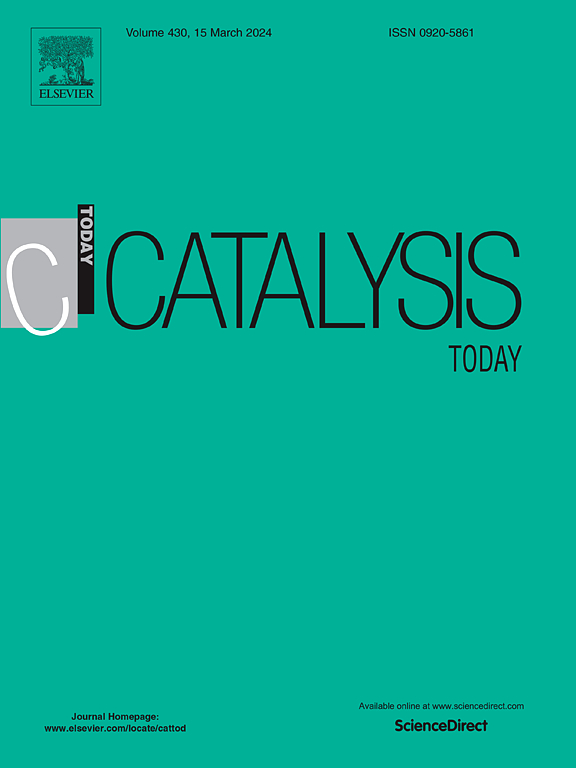锗硅酸盐沸石在环己烯有氧氧化中的催化活性:锗“开”位的影响
IF 5.3
2区 化学
Q1 CHEMISTRY, APPLIED
引用次数: 0
摘要
在这项工作中,我们首次揭示了锗在锗硅酸盐沸石中对环己烯有氧氧化的催化活性。我们的研究结果表明,尽管Ge含量相似,但-ITV框架中的Ge比BEC框架中的Ge表现出更高的催化活性。这一定与两种框架中Ge的不同构型有关,因为-ITV中的Ge位于中断≡T-OH Q3位置,类似于沸石中Ti(IV)和Sn(IV)更活跃的“开放”位置,而在BEC框架中Ge处于Q4“封闭”构型。有趣的是,用1-丁醇预处理这两种焙烧的锗硅酸盐材料都能显著提高催化活性,特别是在诱导期缩短方面。详细的光谱研究揭示了环己烯与-ITV框架中≡Ge- oh中断位点的特殊相互作用,显示出两种类型的相互作用,通过氢键和通过与Ge的直接相互作用。此外,在BEC和-ITV框架中,环己烯都与Ge位点形成了某种类型的配合物,但它们的性质不同,这表明Ge能够以某种方式预先激活环己烯进行氧化反应。本文章由计算机程序翻译,如有差异,请以英文原文为准。
Catalytic activity of germanosilicate zeolites in the aerobic oxidation of cyclohexene: Effect of Ge ‘open’ sites
In this work we disclose for the first time the catalytic activity of Ge in germanosilicate zeolites for the aerobic oxidation of cyclohexene. Our results show that Ge in the -ITV framework displays a higher catalytic activity than Ge in the BEC framework, despite having a similar Ge content. This must be related to the different configuration of Ge in both frameworks, since Ge in -ITV locates preferably in interrupted ≡T-OH Q3 positions, similar to the more active ‘open’ sites of Ti(IV) and Sn(IV) in zeolites, while in the BEC framework Ge is in Q4 ‘closed’ configuration. Interestingly, pre-treatment of both calcined germanosilicate materials with 1-butanol results in a notable improvement of the catalytic activity, especially in terms of a reduction of the induction period. A detailed spectroscopic study reveals a special interaction of cyclohexene with ≡Ge-OH interrupted sites in the -ITV framework, displaying two types of interactions, through H-bonding and through a direct interaction with Ge. Moreover, cyclohexene is shown to form some type of complex with Ge sites in both BEC and -ITV frameworks, but they show a different nature as revealed by their distinct UV absorption bands, suggesting that Ge is able to pre-activate in some way cyclohexene for the oxidation reaction.
求助全文
通过发布文献求助,成功后即可免费获取论文全文。
去求助
来源期刊

Catalysis Today
化学-工程:化工
CiteScore
11.50
自引率
3.80%
发文量
573
审稿时长
2.9 months
期刊介绍:
Catalysis Today focuses on the rapid publication of original invited papers devoted to currently important topics in catalysis and related subjects. The journal only publishes special issues (Proposing a Catalysis Today Special Issue), each of which is supervised by Guest Editors who recruit individual papers and oversee the peer review process. Catalysis Today offers researchers in the field of catalysis in-depth overviews of topical issues.
Both fundamental and applied aspects of catalysis are covered. Subjects such as catalysis of immobilized organometallic and biocatalytic systems are welcome. Subjects related to catalysis such as experimental techniques, adsorption, process technology, synthesis, in situ characterization, computational, theoretical modeling, imaging and others are included if there is a clear relationship to catalysis.
 求助内容:
求助内容: 应助结果提醒方式:
应助结果提醒方式:


